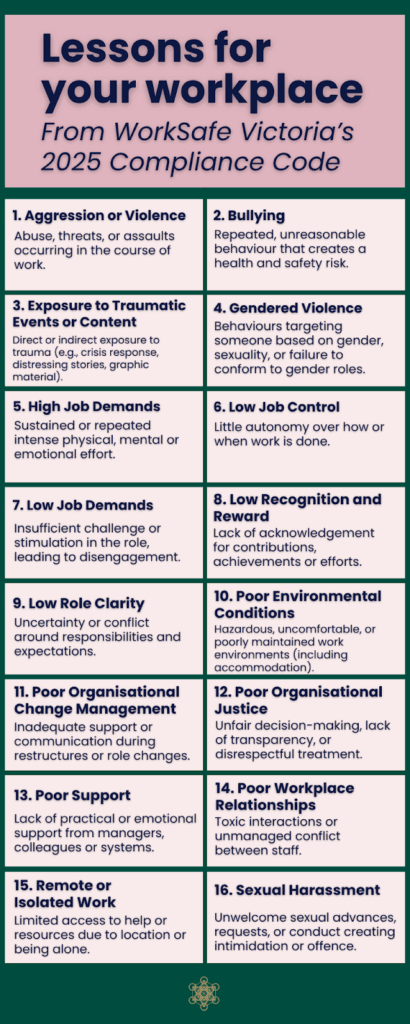As of 1 December, new psychological health compliance codes are now enforceable in Victoria – a move that rightly places greater responsibility on employers to address psychosocial hazards in the workplace.
Australia-wide, not just in one state.
Long before a policy is breached or a risk report is filed, the human body has already been sounding the alarm.
At The Healing Centre of Australia (THCA), we believe that workplace psychological health cannot be managed through compliance alone. Real wellbeing starts in the body, and leaders must learn to see the signs, support regulation, and create space for healing.
It is about more than just awareness
The new compliance code identifies 16 psychosocial hazards, from high job demands and low role clarity to bullying and exposure to trauma. These are critical to name, but knowing about them isn’t enough.
Stress and trauma are not just cognitive experiences, they are physiological. They live in the nervous system and shape how people relate, focus, communicate, and cope.
When organisations ignore the body, they miss the root of the issue. And they miss the opportunity to support their people, not just tick the compliance box.

While these hazards are diverse, they share one thing in common, they affect the nervous system. The body experiences these conditions as chronic stress, fear, or unsafety – and left unaddressed, this leads to burnout, disconnection, and disengagement.
The body matter and stress lives in the nervous system
Before someone burns out, they’re often operating in a prolonged state of fight, flight, freeze or fawn. Before a conflict erupts, someone’s nervous system has likely been signalling distress for weeks.
In other words, our bodies often know we’re not safe before our minds catch up.
Here’s what happens when psychosocial hazards accumulate without intervention:
- The stress response system stays switched on
- Emotional regulation becomes harder
- People become reactive, withdrawn or shutdown
- Connection and collaboration break down
This is why psychological safety must be felt, not just stated. And that feeling? It starts in the body.
The role of regulation
We can’t think our way out of stress. Regulation is what allows the body to move from a reactive state to a responsive one, and from survival into presence, clarity and performance.
At THCA, our body-based tools help individuals and teams:
- Reconnect with the breath and regulate their nervous system
- Release built-up stress or emotional residue
- Develop deeper awareness of internal states
- Restore a sense of calm, connection and safety
These include modalities like:
- Trauma-informed mindfulness and reiki
- Sound of Being™ sound healing sessions
- Silent retreats and presence-based leadership practices
How we support organisations with wellness
Here’s what a body-based wellbeing culture looks like:
- Policy meets practice: Yes, you have processes. But you also build in pause, reflection, nervous system check-ins and space to feel.
- Safety is a lived experience: Leaders are trained to notice regulation and dysregulation, in themselves and others.
- Wellbeing is collective: Teams share rituals that support decompression, connection and repair, not just performance.
This is the difference between a workplace that knows about mental health, and one that embeds it.
A place for wellness, calm and mindfulness
At THCA, we combine clinical expertise with holistic practice. Our programs are grounded, accessible and tailored to the realities of modern work.
Whether through team sound healing, a retreat, or trauma-informed leadership support, our focus is always the same: to regulate, reconnect and renew.
Resources
Explore the full Compliance Code: Psychological Health (2025):
Download from WorkSafe Victoria
Ready to embed this approach in your team or workplace?
Explore our Corporate Wellness Programs or get in touch.




